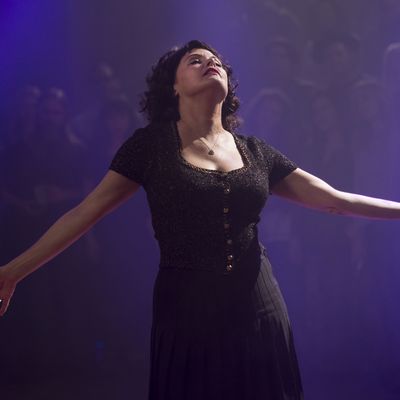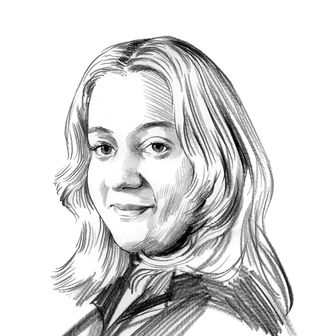
For some viewers, the long-awaited return of Twin Peaks’ resident babe Audrey Horne proved to be nothing short of maddening: It took 12 episodes into The Return to give her some screen time — 12! — and when we finally did see her, she was removed from the main narratives in favor of a convoluted conversation involving characters we’ve never previously seen, heard of, or discussed. (Where the hell are ya, Billy?) Little by little we were mercilessly teased as to why she was so intent on finding her lover while spewing “fuck you!” ramblings to her actual husband, but in this week’s episode, our patience paid off. Well, kind of. After making it to the Roadhouse in pursuit of her beau, the introduction of a surreal “Audrey’s Dance” acid-jazz sequence confirmed what many people were already suspecting: Everything was a dream, and she snapped out of the fantasy to find herself in a bright white room. In short, something’s very wrong with Audrey.
While theorizing about what’s going on in David Lynch’s universe may prove futile, we can’t help but speculate what he has in store for Audrey ahead of Sunday night’s two-part finale. None of the following options are particularly optimistic.
She’s in a coma.
This is the most popular theory, but nothing is as straightforward as it seems. It’s possible Audrey never woke up following the events of the bank explosion 25 years ago, remaining in a coma at Twin Peaks’ local hospital without any hope of waking up as the years passed by. (Hey, she comes from money. The Horne family can definitely afford it.) This lines up with the 20-something Richard saying she’s his mother, and Agent Cooper’s “Mr. C” doppleganger bidding farewell to “my son” upon Richard’s electrocution death, which pretty much confirms that Mr. C raped Audrey when he visited her in the hospital many years prior, subsequently producing Richard. However, there are two brief comments from other characters that dispel this coma idea. In the only scene featuring Doc Hayward, he tells Sheriff Truman via Skype that Audrey “was in a coma,” indicating that she’s not any longer. And in one of the many scenes with Ben and his new assistant, Beverly, he tells her that Richard likely became so disturbed because he never grew up with a father in his life — but there’s no mention of him not having a mother. In fact, there’s no mention of Audrey at all.
She’s in a psych ward.
It wouldn’t come as a surprise if Audrey found herself institutionalized due to the traumatic events she faced after her high-school years. Think about it: Mr. C, who she believes is the all-around swell guy Agent Cooper, brutally betrays her and rapes her in a hospital. Becoming a single mother at an early age grows even more difficult when Richard slowly turns into a demon child, ultimately breaking her mental sanity when she can’t appropriately control her son any longer. (Some viewers have also pointed to a potential multiple-personality disorder at play here, as a means for Audrey to cope with this unpleasant familial dynamic.) This could potentially explain the presence of her “husband,” Charlie, in her dreams, as he could be a psychiatrist or doctor in the hospital serving as some sort of a gatekeeper figure. But perhaps most importantly, think back to what Monica Bellucci told Gordon Cole in his dream a few episodes prior: “We’re like the dreamer who dreams and then lives inside the dream. But who is the dreamer?” Ladies and gentleman, that dreamer could be Audrey.
She’s trapped in a Lodge.
While the glaring fluorescent lights (and a simple mirror) in Audrey’s back-to-reality moment indicate a hospital setting more so than an otherworldly environ, Episode 16’s credit sequence says it all: “Audrey’s Dance” and its accompanying musicians are played backward, indicating some Lodge-y activities are at play. Remember: Everyone moves and speaks backward in the Red Room. This would certainly bring a new meaning to “White Lodge.”
She’s a tulpa.
As we now know with Diane, after Mr. C raped her, he brought her to an “old gas station” — a.k.a. that supernatural convenience store with the woodsmen — and made her into a tulpa (a being created with the power of thought, like an imaginary friend) to help facilitate his evil deeds. The location of the “real” Diane is unknown. He could’ve done the same to Audrey after he paid her that hospital visit. Whether we’re seeing the tulpa or the “real” Audrey in her scenes, though, is another story entirely.


